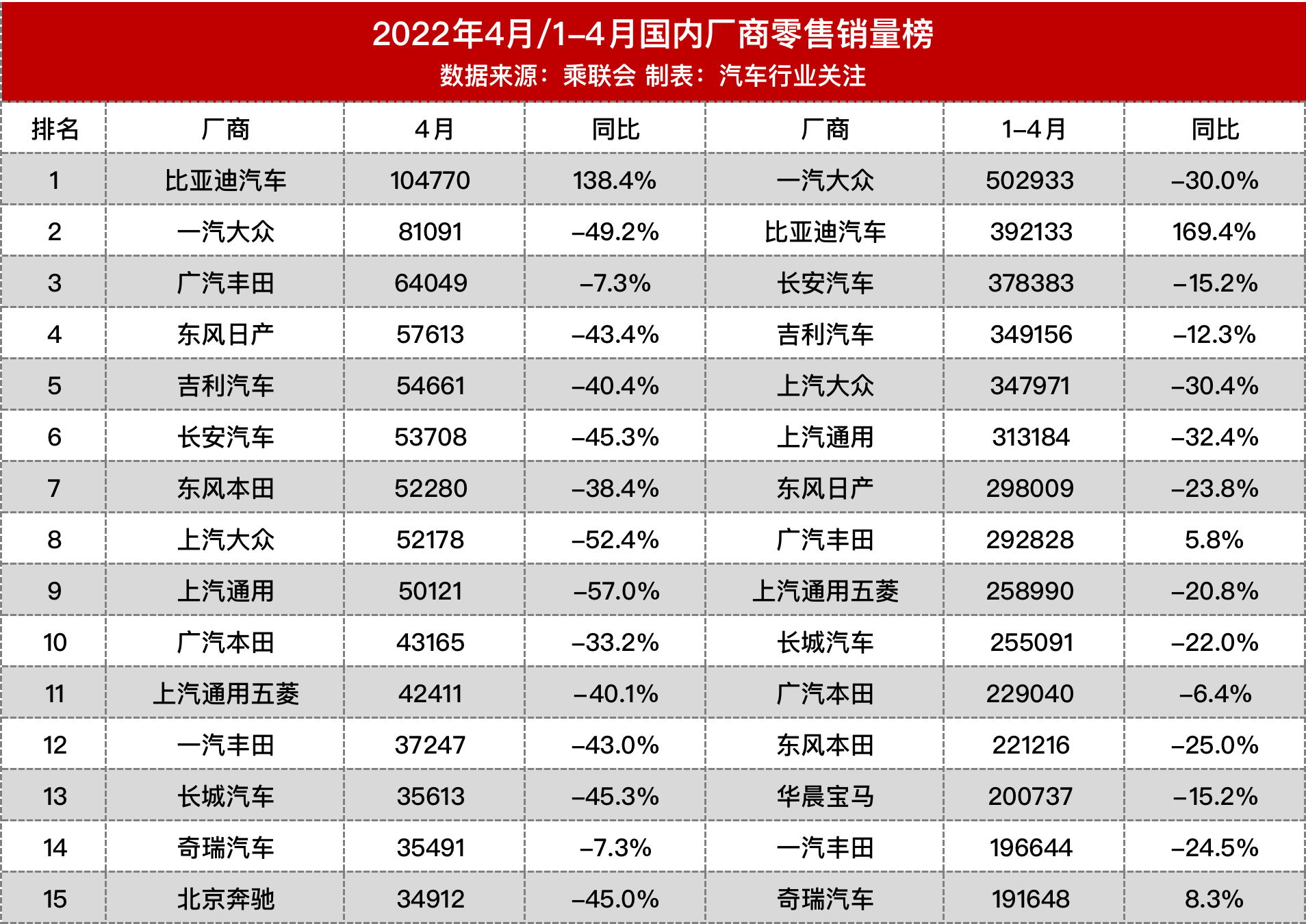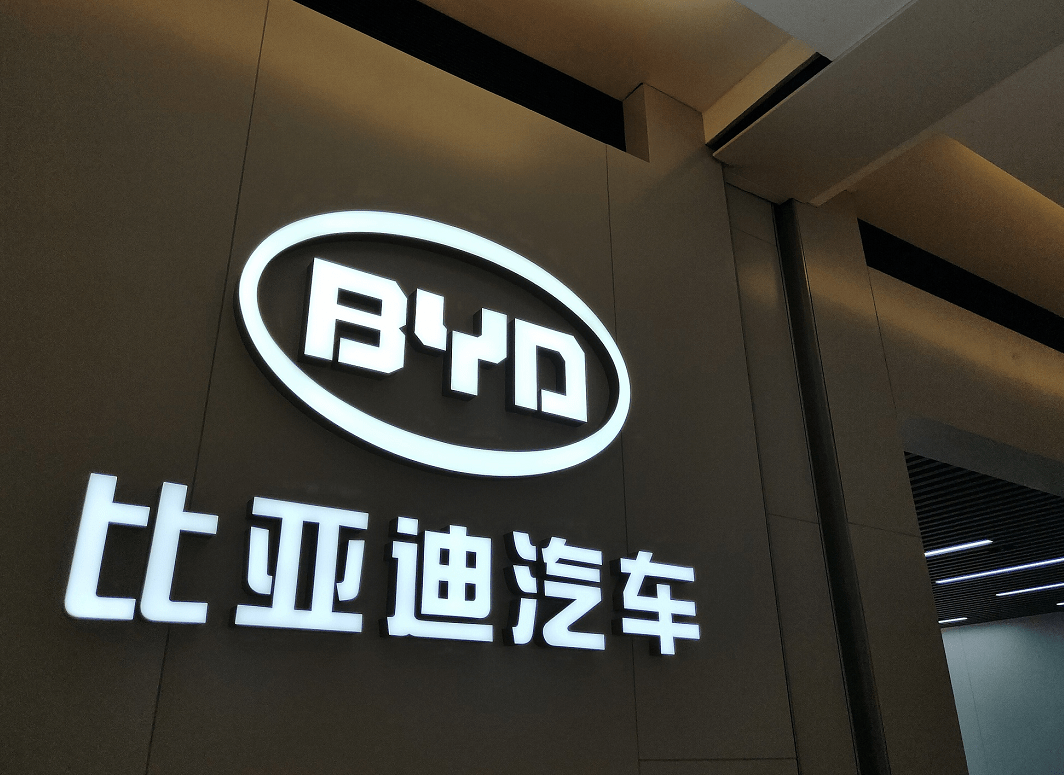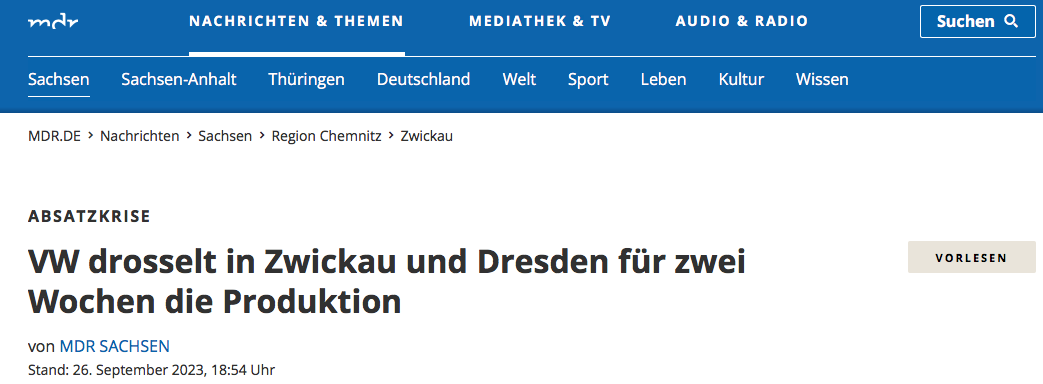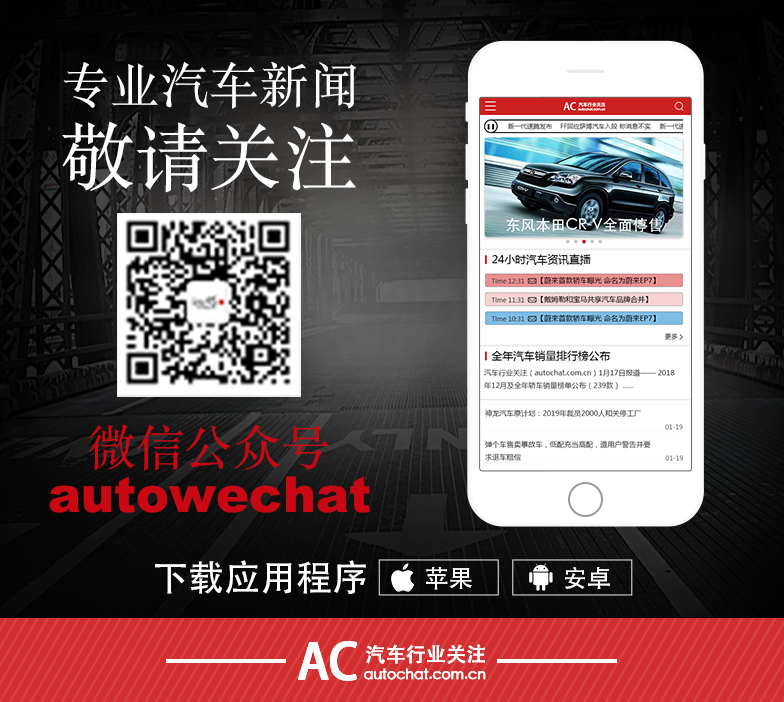In addition to Weibo, there is also WeChat
Please pay attention

WeChat public account
AutoBeta


2024-11-22 Update From: AutoBeta autobeta NAV: AutoBeta > News >
Share
AutoBeta(AutoBeta.net)05/11 Report--
According to data from the Federation of passengers, the passenger car market retailed 1.042 million vehicles in April 2022, down 35.5% from the same period last year and 34.0% from the previous month. According to the concern and analysis of the automobile industry, the main reason for the sharp decline in passenger car sales in April was the epidemic. Affected by the epidemic in Shanghai and Jilin, the already grim supply chain of the automobile industry has become more progressive, while logistics efficiency has led to pressure on end-market delivery.
Due to the influence of the epidemic, the pattern of the automobile industry has been rewritten again, and FAW-Volkswagen, which has won the top spot in passenger car sales for two years in a row, has been overtaken by BYD. Judging from the list, among the top 15 car companies, only BYD achieved year-on-year growth, while other car companies all declined compared with the same period last year. SAIC-Volkswagen and SAIC-GM both halved, with a number of car companies falling more than 40%.

Although the epidemic has dealt a huge blow to China's auto market, independent brands have performed better than joint venture brands, especially BYD. According to the data, BYD's retail sales in April were 104800, up 138.4% from a year earlier, making it the only car company on the list to achieve growth and the only one on the list to sell only new energy vehicles. Auto industry concern analysis believes that the reason why BYD is able to reverse the market growth, in addition to keeping up with the pace of the new energy vehicle market, launching DM plug-in / EV pure electricity and other best-selling models, it has production bases in Shenzhen, Xi'an, Changsha, Changzhou, etc., which can operate normally and ensure its product supply. Data show that in April, BYD had more than 10,000 models, including 25105 in Song, 20292 in Qin, 13406 in Han, 11959 in dolphins, 10107 in Tang and 10079 in Yuan PLUS. Due to BYD's announcement that it would stop production of fuel-fueled vehicles, the above figures were contributed by new energy vehicles.

With the exception of BYD, the performance of other independent brands is not optimistic, including Changan car down 45.3% year-on-year to 53700, Geely car down 40.4% year-on-year to 54700, while Great Wall fell out of the top 10, down 45.3% to 35600. Chery fell less, just 7.3 per cent. The main reason for the sharp decline in sales of the above car companies is that the epidemic in Jiangsu, Shanghai, Zhejiang and Jilin has affected the supply of spare parts, so that even car companies that have not set up factories in the hardest-hit areas have been forced to cut production or stop production. At the same time, the epidemic also led to the disruption of logistics and freight, even if the production could not be delivered to consumers in time.
April was undoubtedly "black" for Volkswagen. Affected by the epidemic in Jilin and Shanghai, North-South Volkswagen sales fell sharply, of which SAIC-Volkswagen in the hardest-hit areas fell 52.4% to 52200 vehicles, while FAW-Volkswagen dropped 49.2% to 81100 vehicles. In mid-March, China FAW announced the suspension of production at its five major vehicle plants in Changchun, Jilin Province. In early April, SAIC Volkswagen and Tesla were shut down due to the escalation of epidemic prevention and control. At the same time, FAW Toyota and SAIC GM, both FAW Toyota and SAIC GM, also suffered a sharp drop in sales due to the epidemic, including FAW Toyota down 43.0% year on year to 37200 vehicles, SAIC GM down 57.0% to 50100 vehicles, and SAIC GM Wuling down 40.1% year on year to 42400 vehicles. At present, the relevant vehicle manufacturers have resumed production, but it still takes a long time to climb to pre-epidemic levels and is still affected by the supply chain in a short period of time.

Of course, "there are no eggs under the nest", other joint venture brands are also not optimistic. Guangzhou Auto Toyota, Dongfeng Nissan, Dongfeng Honda, Guangzhou Auto Honda and other Japanese car companies all entered the TOP 10 list of narrow passenger car manufacturers in April, among which Guangzhou Automobile Toyota had little influence, falling 7.3% to 69000 vehicles compared with the same period last year, which was much lower than that of other joint venture brands. The main reason is that its production base is located in Guangzhou, which is relatively better than other car companies in the worst-hit areas. And Guangzhou Automobile Honda, Dongfeng Honda, Dongfeng Nissan and other joint venture brands have a large decline, to a certain extent, reflecting the serious impact of the parts supply chain.
As a result of this decline, the share of joint venture brands in the Chinese market shrank further in April. Data show that self-branded retail sales of 480000 vehicles in April were down 19 per cent from a year earlier and 37 per cent from a month earlier, while market share rose 9.6 per cent to 46.6 per cent from a year earlier. Retail sales of 450000 mainstream joint venture brands fell 42 per cent from the same period last year and 24 per cent from the previous year, of which the market share of Japanese brands fell 0.5 per cent to 24.5 per cent, German brands dropped 5.2 per cent to 19.4 per cent, and American brands fell 3.1 per cent to 6.4 per cent.
At present, the peak of this round of epidemic in China has gradually passed, and key enterprises in Shanghai, Jilin and other places have also resumed work and production in an orderly manner under the guidance of the Ministry of Industry and Information Technology and other relevant departments, and gradually meet the normal supply and demand of the industrial chain. However, the production end and logistics end of the current automobile market are still facing tremendous pressure. In addition, from the perspective of epidemic prevention and control situation, the epidemic situation in Beijing, Zhengzhou and other places has intensified, epidemic prevention policies in various places have become stricter, and large auto exhibitions such as Beijing Auto Show and Chongqing Auto Show have been postponed, all of which may affect the market sales performance in May.
In May, the epidemic in some domestic cities has not been effectively contained, such as the upgrading of prevention and control policies in Beijing and other places, resulting in transportation delays affecting the delivery of new cars by dealers. At the same time, consumers are expected to cut prices due to factors such as rising oil prices, supply of spare parts, higher prices of new energy and traditional energy vehicles, and demand for cars with a risk aversion mentality will be delayed. The weakening of terminal demand has further curbed the recovery of the car market. Of course, as the epidemic moderates, it is expected to return to pre-epidemic levels by June or July, but it is also difficult to make up for market losses from March to May. Cui Dongshu believes that the epidemic should be a landmark risk event in the automobile industry, which requires the industry and enterprises to seriously consider how to establish a resilient industrial chain system; on the demand side, boosting consumption is the key to recovering losses.
Welcome to subscribe to the WeChat public account "Automotive Industry Focus" to get the first-hand insider information on the automotive industry and talk about things in the automotive circle. Welcome to break the news! WeChat ID autoWechat
Views: 0
*The comments in the above article only represent the author's personal views and do not represent the views and positions of this website. If you have more insights, please feel free to contribute and share.











© 2024 AutoBeta.Net Tiger Media Company. All rights reserved.